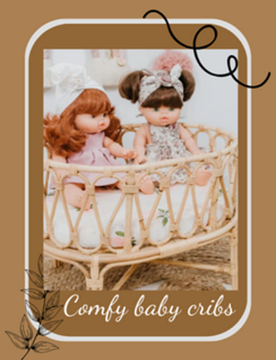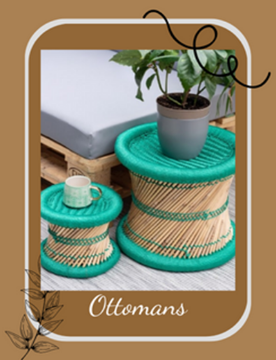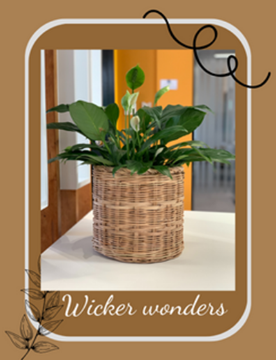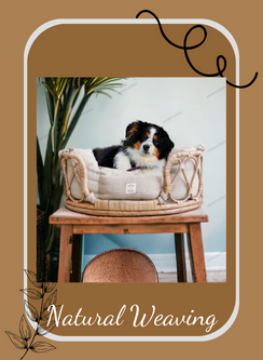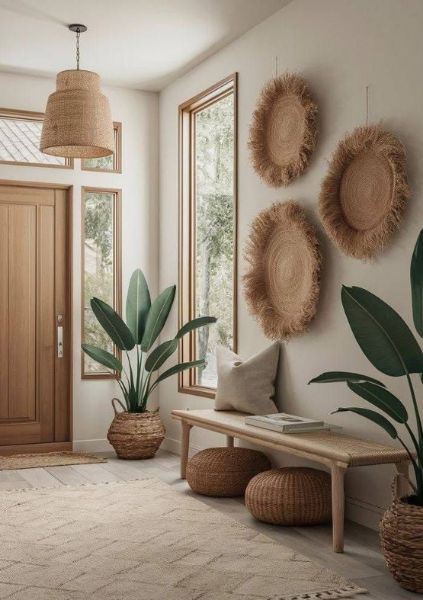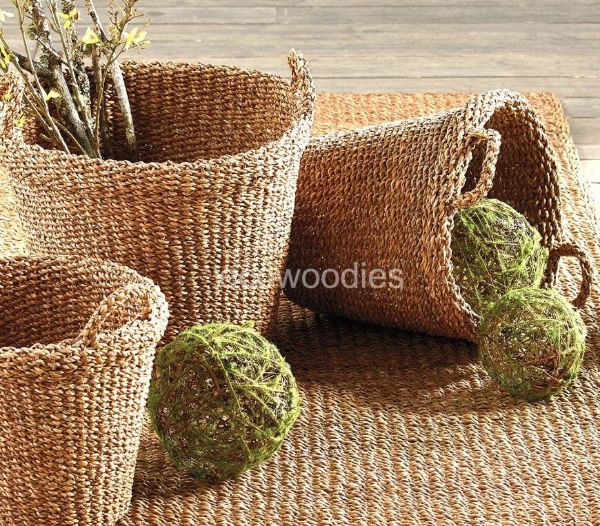Picture this: you walk into a room that instantly transports you to a serene coastal retreat, where natural textures dance with sunlight and every piece of furniture tells a story of sustainable craftsmanship. This isn't just a dream – it's the transformative power of seagrass furniture, nature's gift to contemporary interior design.
In our rapidly evolving world where environmental consciousness meets aesthetic excellence, seagrass furniture has emerged as the perfect marriage of sustainability and style. Whether you're redesigning your living space, searching for eco-friendly alternatives, or simply curious about this remarkable natural material, you're about to discover why seagrass furniture is revolutionizing homes across the globe.
From the bustling apartments of Tokyo to the minimalist lofts of Scandinavia, from the vibrant homes of Mexico to the sophisticated spaces of New York, seagrass furniture is creating waves in the interior design world. But what makes this humble aquatic plant so special, and how does it compare to its natural cousins like bamboo and rattan?
What is Seagrass Furniture? Understanding Nature's Versatile Material
Seagrass furniture represents one of nature's most ingenious solutions to modern living needs. Unlike traditional hardwood furniture that requires decades of tree growth, seagrass is a rapidly renewable marine plant that grows in shallow coastal waters around the world. This aquatic grass, scientifically known from various species including Zostera and Thalassia, has been harvested sustainably for centuries to create durable, beautiful furniture pieces.
The transformation from underwater plant to stunning furniture involves a meticulous process. Seagrass is carefully harvested, dried under controlled conditions, and then woven into various patterns and structures. The result is furniture that carries the essence of the ocean – naturally antimicrobial, incredibly flexible, and surprisingly strong.
What sets seagrass apart from other natural materials is its unique cellular structure. The plant's adaptation to underwater life has created fibers that are naturally water-resistant and remarkably durable. When woven into furniture, these fibers create a surface that's not only beautiful but also practical for everyday use.
The Seagrass Advantage: Why Choose Marine-Based Furniture
Seagrass furniture offers numerous advantages that make it an excellent choice for modern homes:
Sustainability at Its Core: Unlike bamboo which takes 3-5 years to mature or rattan which requires 15-20 years, seagrass grows continuously and can be harvested without damaging the marine ecosystem. This rapid regeneration makes it one of the most sustainable furniture materials available.
Natural Antimicrobial Properties: The marine environment has endowed seagrass with natural resistance to bacteria and mold, making it an ideal choice for homes, especially in humid climates or for families with allergies.
Exceptional Durability: Despite its delicate appearance, properly treated seagrass furniture can last for decades. The interwoven fibers create a surface that distributes weight evenly, preventing wear and tear that might affect other materials.
Climate Adaptability: Whether you live in the dry heat of Arizona or the humid tropics of Southeast Asia, seagrass furniture adapts beautifully to various climates, expanding and contracting naturally without cracking or breaking.
Seagrass vs. Bamboo vs. Rattan: The Natural Material Showdown
Understanding the differences between seagrass, bamboo, and rattan helps you make informed decisions about which natural material best suits your needs, lifestyle, and aesthetic preferences.
Seagrass: The Ocean's Gift
Seagrass brings a unique oceanic aesthetic to any space. Its naturally pale, sandy colors evoke beachside tranquility, while its soft texture provides comfort that's unmatched by harder materials. The weaving patterns possible with seagrass are incredibly diverse, from tight, fine weaves that create smooth surfaces to loose, rustic weaves that add textural interest.
The environmental impact of seagrass furniture is minimal. Harvesting seagrass actually helps maintain healthy marine ecosystems by preventing overgrowth that can block sunlight from reaching other marine life. This symbiotic relationship between furniture production and environmental conservation makes seagrass an exceptional choice for eco-conscious consumers.
Bamboo: The Fast-Growing Champion
Bamboo furniture has gained tremendous popularity due to bamboo's status as the world's fastest-growing plant. Some bamboo species can grow up to 35 inches in a single day, making it an incredibly renewable resource. Bamboo furniture tends to have clean, linear designs that work beautifully in modern and minimalist settings.
The strength-to-weight ratio of bamboo is remarkable – it's actually stronger than many steel alloys while remaining lightweight and flexible. This makes bamboo furniture both durable and easy to rearrange, perfect for dynamic living spaces that change with your needs.
However, bamboo's hardness, while providing durability, can sometimes feel less comfortable than the softer, more yielding surface of seagrass. The choice between bamboo and seagrass often comes down to whether you prioritize structural strength or comfort.
Rattan: The Traditional Favorite
Rattan has been used for furniture making for thousands of years, particularly in Southeast Asian cultures. This climbing palm creates furniture with distinctive curved lines and organic shapes that bring warmth and character to any room.
Rattan's flexibility allows for complex curved designs that would be impossible with rigid materials. The natural variations in rattan cane create furniture pieces that are unique and full of character. However, rattan requires more maintenance than seagrass and can be susceptible to humidity changes.
The processing of rattan is more labor-intensive than seagrass, often reflecting in higher prices. Additionally, rattan harvesting requires careful management to ensure sustainability, as over-harvesting can damage forest ecosystems.
Types of Seagrass Furniture: From Baskets to Statement Pieces
The versatility of seagrass allows for an incredible range of furniture and home decor items, each bringing its own character and functionality to your living space.
Seagrass Storage Solutions
Baskets and Containers: Seagrass baskets are perhaps the most popular entry point into seagrass furniture. Available in countless sizes, shapes, and weaving patterns, these storage solutions combine functionality with natural beauty. From small desktop organizers to large laundry hampers, seagrass baskets bring order to any space while adding textural interest.
Ottomans and Storage Benches: Seagrass ottomans serve dual purposes as comfortable seating and clever storage. The natural give of seagrass makes these pieces comfortable for extended sitting, while their hollow interiors provide hidden storage for blankets, books, or seasonal items.
Wardrobes and Armoires: Large seagrass storage pieces make bold statements while providing substantial storage capacity. These pieces often feature intricate weaving patterns that become focal points in bedrooms or living areas.
Seagrass Seating
Chairs and Dining Sets: Seagrass dining chairs bring casual elegance to meal times. The natural flexibility of seagrass creates seating that conforms to your body, providing comfort during long dinners or work sessions. Many seagrass chairs feature mixed materials, combining seagrass seats with wooden or metal frames for added durability and style variety.
Lounge Chairs and Recliners: For ultimate relaxation, seagrass lounge chairs offer the perfect blend of support and comfort. The natural breathability of seagrass prevents the stuffiness that can occur with synthetic materials, making these chairs ideal for reading nooks or meditation spaces.
Bar Stools and Counter Height Seating: Seagrass bar stools bring organic warmth to kitchen islands and home bars. Their lightweight nature makes them easy to move, while their durability ensures they'll withstand daily use.
Seagrass Tables and Surfaces
Coffee Tables: Seagrass coffee tables often feature woven tops or bases that add textural interest to living rooms. These pieces work beautifully in both casual and formal settings, bringing natural warmth that softens harder materials like metal or glass.
Side Tables and Accent Pieces: Small seagrass tables provide perfect spots for lamps, books, or decorative objects. Their lightweight nature makes them easy to relocate as your room's needs change.
Dining Tables: While less common than other seagrass furniture types, seagrass dining tables make stunning centerpieces for homes that embrace natural materials throughout their design.
Decorative Seagrass Elements
Wall Hangings and Art: Seagrass wall hangings bring three-dimensional texture to walls, creating focal points that change throughout the day as light moves across their surfaces.
Planters and Garden Accessories: Seagrass planters provide natural containers for houseplants, creating seamless connections between indoor and outdoor spaces.
Lighting Fixtures: Seagrass pendant lights and lampshades create warm, diffused lighting that enhances the cozy atmosphere seagrass furniture naturally provides.
Benefits of Choosing Seagrass Furniture
The decision to incorporate seagrass furniture into your home brings numerous benefits that extend far beyond mere aesthetics.
Environmental Benefits
Carbon Footprint Reduction: Seagrass furniture has one of the smallest carbon footprints of any furniture material. The plants absorb CO2 as they grow, and the harvesting and manufacturing processes require minimal energy compared to traditional furniture production.
Ocean Health Support: Sustainable seagrass harvesting actually supports marine ecosystem health. Seagrass beds provide crucial habitat for marine life, and responsible harvesting maintains these ecosystems while providing renewable materials.
Biodegradability: At the end of its useful life, seagrass furniture can be composted or recycled back into the earth, creating no lasting environmental impact.
Water Conservation: Unlike cotton or other textile crops used in furniture, seagrass requires no irrigation, fertilizers, or pesticides, conserving precious freshwater resources.
Health and Wellness Benefits
Air Quality Improvement: Seagrass furniture doesn't off-gas volatile organic compounds (VOCs) like many synthetic materials. This means better indoor air quality for you and your family.
Allergen Resistance: The natural antimicrobial properties of seagrass make it resistant to dust mites, mold, and bacteria that can trigger allergies and respiratory issues.
Electromagnetic Field (EMF) Neutrality: Unlike furniture with metal frames or synthetic materials, seagrass furniture doesn't conduct or amplify electromagnetic fields, potentially contributing to better sleep and overall wellness.
Stress Reduction: The natural textures and colors of seagrass furniture have been shown to reduce stress and promote relaxation, contributing to better mental health and wellbeing.
Practical Benefits
Durability: High-quality seagrass furniture can last for decades with proper care. The interwoven fibers distribute stress evenly, preventing the weak points that can develop in other materials.
Lightweight Design: Seagrass furniture is significantly lighter than comparable wooden pieces, making it easy to rearrange your space or move to new homes.
Temperature Regulation: Seagrass naturally regulates temperature, staying cool in summer and providing insulation in winter, contributing to year-round comfort.
Moisture Management: The natural fiber structure of seagrass wicks away moisture, preventing the stuffiness that can occur with synthetic materials.
Styling Your Home with Seagrass Furniture
Incorporating seagrass furniture into your home design opens up exciting possibilities for creating spaces that feel both sophisticated and naturally relaxed.
Coastal and Beach House Styling
Seagrass furniture is a natural fit for coastal-inspired interiors. Pair seagrass pieces with soft blues, sandy beiges, and crisp whites to create spaces that feel like permanent vacations. Consider these styling tips:
Layer Textures: Combine seagrass furniture with linen fabrics, jute rugs, and driftwood accessories to create rich textural landscapes that invite touch and exploration.
Embrace Natural Light: Position seagrass furniture near windows where natural light can highlight the beautiful weaving patterns and create interesting shadows throughout the day.
Add Coastal Colors: Soft corals, sea glass greens, and sunset oranges complement seagrass beautifully while maintaining the coastal theme.
Modern Minimalist Approaches
Seagrass furniture works surprisingly well in minimalist settings, where its natural beauty can shine without competition from busy patterns or colors.
Clean Lines: Choose seagrass pieces with simple, geometric shapes that complement minimalist aesthetics while adding necessary warmth and texture.
Neutral Palettes: Combine seagrass with whites, grays, and other earth tones to create sophisticated spaces that feel calm and uncluttered.
Functional Beauty: Select seagrass pieces that serve multiple purposes, such as storage ottomans or nesting tables, to maintain minimalist principles while adding natural elements.
Bohemian and Eclectic Designs
The relaxed nature of seagrass furniture makes it perfect for bohemian-inspired interiors that celebrate creativity and personal expression.
Mix and Match: Combine different seagrass weaving patterns and sizes to create eclectic arrangements that feel curated over time.
Global Influences: Pair seagrass with textiles and accessories from various cultures to create worldly, well-traveled aesthetics.
Layered Comfort: Use multiple seagrass pieces – floor cushions, ottomans, and chairs – to create flexible seating arrangements perfect for entertaining.
Scandinavian Hygge
The Danish concept of hygge, which emphasizes comfort and contentment, aligns perfectly with seagrass furniture's natural warmth.
Cozy Textures: Layer seagrass furniture with wool throws, sheepskin rugs, and other natural textures to create spaces that invite relaxation.
Neutral Tones: Stick to the Scandinavian palette of whites, grays, and natural wood tones, allowing seagrass pieces to add subtle warmth.
Functional Design: Choose seagrass pieces that embody Scandinavian design principles of functionality and simplicity.
Care and Maintenance of Seagrass Furniture
Proper care ensures that your seagrass furniture remains beautiful and functional for many years. While seagrass is naturally durable, following these maintenance guidelines will maximize your investment.
Daily Care Routines
Regular Dusting: Use a soft brush or vacuum with a brush attachment to remove dust and debris from seagrass surfaces. Work in the direction of the weave to avoid catching and damaging fibers.
Immediate Spill Management: Clean spills immediately with a clean, dry cloth. Blot rather than rub to prevent pushing liquids deeper into the weave.
Rotation and Movement: Periodically rotate or move seagrass furniture to ensure even wear and prevent permanent indentations from heavy items.
Deep Cleaning Techniques
Gentle Cleaning Solutions: For deeper cleaning, use a mild soap solution applied with a barely damp cloth. Avoid soaking the seagrass, as excessive moisture can cause damage.
Steam Cleaning: Professional steam cleaning can refresh seagrass furniture without over-wetting the material. Ensure the cleaner has experience with natural fiber furniture.
Stain Treatment: For stubborn stains, create a paste with baking soda and water. Apply gently, let sit for a few hours, then brush away with a soft brush.
Seasonal Maintenance
Humidity Control: In very dry climates, light misting can prevent seagrass from becoming brittle. In humid climates, ensure good air circulation to prevent moisture buildup.
UV Protection: While seagrass has natural UV resistance, prolonged direct sunlight can cause fading. Use window treatments or position furniture away from intense direct sunlight.
Professional Inspection: Have valuable seagrass pieces professionally inspected annually to identify and address any structural issues before they become major problems.
Storage and Protection
Climate-Controlled Storage: When storing seagrass furniture, choose climate-controlled environments that maintain consistent temperature and humidity.
Protective Covers: Use breathable furniture covers to protect seagrass pieces from dust while allowing air circulation.
Proper Support: Store seagrass furniture with proper support to prevent sagging or warping during extended storage periods.
Global Perspectives: Seagrass Furniture Around the World
The appreciation for seagrass furniture spans cultures and continents, with different regions bringing their own aesthetic interpretations and traditional uses to this versatile material.
Asian Influences
In many Asian cultures, seagrass furniture represents harmony between human needs and natural resources. Traditional Japanese design principles of wabi-sabi find perfect expression in seagrass pieces, where the natural variations and imperfections are celebrated rather than hidden.
Japanese Aesthetics: Seagrass furniture complements Japanese interiors that value simplicity, natural materials, and connection to nature. Floor cushions and low tables made from seagrass support traditional sitting styles while providing modern comfort.
Southeast Asian Traditions: Countries like Vietnam, Thailand, and the Philippines have long traditions of working with natural fibers. Local artisans create seagrass furniture that reflects regional weaving techniques and cultural motifs.
Chinese Feng Shui: In feng shui practice, seagrass furniture is valued for its ability to bring natural energy into homes while maintaining the flow of chi through spaces.
European Elegance
European designers have embraced seagrass furniture as a way to bring warmth and texture to often minimalist or traditional interiors.
Scandinavian Integration: Nordic countries incorporate seagrass furniture into their famous hygge lifestyle, where natural materials create cozy, comfortable living spaces that support wellbeing.
Mediterranean Coastal Style: In coastal Mediterranean regions, seagrass furniture perfectly complements the relaxed, sun-soaked lifestyle, pairing beautifully with whitewashed walls and blue accents.
British Country Style: In the UK, seagrass furniture has found its place in country house aesthetics, where it brings casual elegance to formal settings.
American Adaptations
Across America, seagrass furniture has been adapted to suit diverse regional styles and climates.
California Cool: West Coast designers use seagrass furniture to create laid-back, surf-inspired interiors that celebrate outdoor living and natural materials.
Southern Charm: In the American South, seagrass furniture complements traditional hospitality-focused design, creating comfortable spaces for gathering and entertaining.
Desert Southwest: In Arizona and New Mexico, seagrass furniture provides textural contrast to the stark beauty of desert landscapes while maintaining the natural aesthetic.
African and Middle Eastern Traditions
These regions have incorporated seagrass furniture into traditional designs that celebrate handcraftsmanship and community gathering.
Moroccan Influences: Seagrass furniture works beautifully with Moroccan design elements, providing neutral foundations for rich colors and intricate patterns.
Sub-Saharan Techniques: Traditional African weaving techniques inspire modern seagrass furniture designs that honor cultural heritage while meeting contemporary needs.
Buying Guide: How to Choose Quality Seagrass Furniture
Selecting high-quality seagrass furniture requires understanding what to look for and where to find the best pieces for your needs and budget.
Quality Indicators
Weave Consistency: High-quality seagrass furniture features consistent, tight weaving with no loose or protruding fibers. The pattern should be even throughout the piece.
Color Uniformity: While natural variation is expected, quality pieces should have relatively uniform coloring without dramatic dark or light patches that might indicate poor processing.
Structural Integrity: Test the structural soundness by gently pressing on different areas of the furniture. Quality pieces should feel solid and stable with no excessive give or movement.
Edge Finishing: Well-made seagrass furniture has clean, finished edges where the weaving is properly secured and won't unravel over time.
Frame Materials
Wooden Frames: Look for frames made from sustainable hardwoods that complement the seagrass. The wood should be properly finished and free from defects.
Metal Frames: If choosing seagrass furniture with metal frames, ensure the metal is properly treated to prevent rust and corrosion, especially in humid environments.
All-Seagrass Construction: Some pieces are made entirely from seagrass without additional framing. These require even higher quality weaving and construction techniques.
Size and Proportion
Room Scale: Consider the scale of your room when selecting seagrass furniture. Large pieces can overwhelm small spaces, while tiny pieces may look lost in grand rooms.
Functional Requirements: Ensure the furniture meets your practical needs in terms of storage capacity, seating comfort, or surface area.
Growth Planning: Consider whether the piece will work as your needs change over time, such as when families grow or living situations evolve.
Budget Considerations
Investment Pieces: High-quality seagrass furniture is an investment that can last decades. Consider the cost per year of use when evaluating prices.
Starter Pieces: Begin with smaller, less expensive seagrass items like baskets or small stools to test your satisfaction before investing in larger pieces.
Seasonal Sales: Many retailers offer significant discounts on natural fiber furniture during off-peak seasons, typically late winter and early spring.
DIY and Customization Options
For those who enjoy hands-on projects, seagrass offers numerous opportunities for customization and do-it-yourself creation.
Simple DIY Projects
Basket Weaving: Start with simple basket projects using purchased seagrass cord. These make excellent gifts and provide valuable experience working with the material.
Furniture Repair: Learn basic repair techniques for maintaining existing seagrass furniture, including re-weaving damaged sections and reinforcing weak areas.
Decorative Wrapping: Use seagrass to wrap plain furniture frames, creating custom pieces that reflect your personal style.
Advanced Customization
Recoloring Techniques: While seagrass naturally takes on beautiful tones, some advanced crafters experiment with natural dyes to create custom colors.
Mixed Media Projects: Combine seagrass with other natural materials like bamboo, rattan, or wood to create unique hybrid pieces.
Professional Restoration: Work with skilled artisans to restore valuable vintage seagrass pieces or modify existing furniture to better suit your needs.
Tools and Materials
Basic Hand Tools: Simple tools like needles, scissors, and pliers are sufficient for most seagrass projects.
Specialized Equipment: For advanced projects, consider investing in specialized weaving tools and frames designed for natural fiber work.
Material Sourcing: Find reliable suppliers of quality seagrass materials, ensuring you're getting properly processed fibers suitable for furniture making.
Environmental Impact and Sustainability
Understanding the environmental implications of choosing seagrass furniture helps make informed decisions that align with personal values and global sustainability goals.
Positive Environmental Impacts
Carbon Sequestration: Seagrass beds are among the most effective carbon sinks on Earth, storing carbon at rates up to 35 times faster than tropical rainforests.
Marine Ecosystem Support: Sustainable seagrass harvesting supports healthy marine ecosystems that provide habitat for fish, sea turtles, and other marine life.
Renewable Resource Management: Properly managed seagrass harvesting creates economic incentives for protecting marine environments.
Reduced Manufacturing Impact: The simple processing required to transform seagrass into furniture uses minimal energy and produces little waste.
Sustainability Certifications
Marine Stewardship Council (MSC): Look for seagrass products certified by organizations that verify sustainable harvesting practices.
Fair Trade Certification: Some seagrass furniture carries fair trade certification, ensuring that producers receive fair compensation for their work.
Environmental Management Systems: Manufacturers with ISO 14001 certification demonstrate commitment to environmental responsibility throughout their operations.
Supporting Sustainable Practices
Research Manufacturers: Choose manufacturers who transparently share information about their sourcing and production practices.
Local Sourcing: When possible, select seagrass furniture made from locally sourced materials to reduce transportation impacts.
End-of-Life Planning: Consider how you'll dispose of seagrass furniture at the end of its useful life, planning for composting or recycling when possible.
Cost Analysis: Is Seagrass Furniture Worth the Investment?
Understanding the true cost of seagrass furniture requires looking beyond initial purchase prices to consider long-term value, durability, and replacement costs.
Initial Investment Ranges
Entry-Level Pieces: Small seagrass accessories like baskets and placemats typically range from $20-100, providing affordable ways to incorporate the material into your home.
Mid-Range Furniture: Chairs, ottomans, and small tables generally cost $200-800, offering good value for quality pieces that will see regular use.
Premium Collections: Large furniture pieces like dining sets, storage systems, and custom pieces can range from $1,000-5,000 or more, representing significant investments in sustainable, long-lasting furniture.
Long-Term Value Calculations
Durability Factor: Quality seagrass furniture can last 20-30 years or more with proper care, making the cost per year of use very reasonable compared to cheaper alternatives that require frequent replacement.
Maintenance Costs: Seagrass furniture requires minimal maintenance, with occasional professional cleaning being the primary ongoing expense.
Resale Value: Well-maintained seagrass furniture often retains good resale value, particularly for designer pieces or unique vintage items.
Comparison with Alternatives
Synthetic Furniture: While synthetic furniture may cost less initially, it typically has shorter lifespans and creates environmental disposal problems.
Traditional Wood Furniture: High-quality wood furniture may last longer but often costs significantly more initially and requires more maintenance over time.
Fast Furniture: Inexpensive furniture may seem attractive initially but replacement costs add up quickly, often exceeding the cost of quality seagrass pieces over time.
Future Trends in Seagrass Furniture Design
The seagrass furniture industry continues to evolve, with exciting developments in design, manufacturing, and application.
Technology Integration
Smart Manufacturing: Advanced weaving technologies are creating more consistent, durable seagrass products while maintaining the handcrafted aesthetic that makes these pieces special.
Hybrid Materials: Innovative combinations of seagrass with other sustainable materials like recycled plastics or bio-based composites are creating new possibilities for furniture design.
Performance Enhancement: Research into natural treatments and finishes is improving seagrass furniture's resistance to stains, moisture, and wear while maintaining its eco-friendly properties.
Design Evolution
Contemporary Aesthetics: Modern designers are creating seagrass furniture that works in ultra-contemporary settings, challenging traditional assumptions about where natural materials belong.
Customization Options: Increasing availability of custom seagrass furniture allows consumers to get exactly what they need while supporting artisan craftspeople.
Modular Systems: Modular seagrass furniture systems allow for flexible arrangements that can evolve with changing needs and spaces.
Market Expansion
Global Availability: Improved supply chains are making high-quality seagrass furniture available in markets that previously had limited access.
Price Accessibility: Economies of scale and improved manufacturing efficiency are making seagrass furniture more accessible to broader market segments.
Commercial Applications: Hotels, restaurants, and offices are increasingly incorporating seagrass furniture to create welcoming, sustainable environments.
Frequently Asked Questions
1. Is seagrass furniture suitable for households with pets and children?
Seagrass furniture is excellent for families with pets and children. The natural antimicrobial properties of seagrass make it resistant to bacteria and odors that can accumulate from pets. For children, seagrass furniture provides safe, non-toxic surfaces free from harmful chemicals found in many synthetic materials. The woven texture is interesting for children to touch and explore, supporting sensory development. However, be aware that pets with a tendency to chew might damage seagrass furniture, so supervision may be necessary during the initial adjustment period. The durability of seagrass also means it can withstand the active lifestyle of families with children, bouncing back from the inevitable bumps and spills that come with family life.
2. How does seagrass furniture perform in different climates?
Seagrass furniture adapts remarkably well to various climates due to its natural properties developed through marine evolution. In humid climates, seagrass naturally regulates moisture, preventing the stuffiness and mold issues that can affect other materials. The fibers expand and contract naturally with humidity changes without cracking or splitting. In dry climates, seagrass may benefit from occasional light misting to prevent brittleness, but its natural flexibility helps it maintain structural integrity even in arid conditions. Temperature variations don't significantly affect seagrass furniture, as the material naturally insulates in cold weather and stays cool in warm weather. However, extreme temperature fluctuations should be avoided, and positioning furniture away from heating vents or air conditioning units helps maintain optimal condition.
3. Can seagrass furniture be repaired if damaged?
One of the great advantages of seagrass furniture is its repairability. Minor damage like loose weaving or small tears can often be repaired using matching seagrass materials and basic weaving techniques. Many furniture restoration specialists now work with natural fiber furniture and can handle more complex repairs. For DIY repairs, simple re-weaving of small sections is possible with patience and the right materials. Prevention is always better than repair, so regular maintenance and careful use help avoid damage. When purchasing seagrass furniture, ask the manufacturer about repair services or warranty options. Some higher-end pieces come with repair guarantees or access to craftspeople who can restore the furniture to original condition. Learning basic maintenance and minor repair techniques can significantly extend the life of your seagrass furniture investment.
Conclusion: Embracing Sustainable Style with Seagrass Furniture
As we've explored throughout this comprehensive guide, seagrass furniture represents far more than just another design trend – it embodies a conscious choice toward sustainable living without compromising on style, comfort, or durability. From its humble origins in coastal waters to its transformation into sophisticated furniture pieces gracing homes worldwide, seagrass has proven itself as a material perfectly suited for our environmentally conscious age.
The journey through seagrass furniture reveals a world where environmental responsibility meets aesthetic excellence. Whether you're drawn to the coastal charm it brings to beach house settings, the textural warmth it adds to minimalist spaces, or the sustainable story it tells about our relationship with natural resources, seagrass furniture offers solutions that resonate with both our practical needs and our values.
The comparison with bamboo and rattan furniture highlights seagrass's unique position in the natural materials landscape. While each material has its strengths, seagrass stands out for its rapid renewability, natural antimicrobial properties, and incredible adaptability to various design styles and climates. This versatility, combined with its minimal environmental impact, makes seagrass furniture an investment in both your home's beauty and our planet's future.
The global perspective on seagrass furniture demonstrates how this material transcends cultural boundaries while respecting local traditions and aesthetics. From Scandinavian hygge to Mediterranean coastal style, from Asian minimalism to American eclectic design, seagrass furniture adapts and enhances whatever design philosophy you embrace.
Perhaps most importantly, choosing seagrass furniture represents a shift toward more thoughtful consumption. In a world often dominated by fast furniture and disposable design, seagrass pieces offer longevity, repairability, and end-of-life biodegradability that aligns with sustainable living principles. The initial investment in quality seagrass furniture pays dividends not just in years of beautiful, functional use, but in the satisfaction of making environmentally responsible choices.
The future of seagrass furniture looks bright, with innovations in design, manufacturing, and application expanding its possibilities while maintaining its core environmental benefits. As more consumers seek sustainable alternatives to traditional furniture materials, seagrass is positioned to play an increasingly important role in home design and environmental stewardship.
Ready to Transform Your Space with Seagrass Furniture?
Your journey into sustainable, stylish living starts with a single piece. Whether you're ready to make a statement with a stunning seagrass dining set or want to test the waters with a beautiful storage basket, now is the perfect time to discover how seagrass furniture can transform your home.
Visit your local sustainable furniture retailers to experience the texture and beauty of seagrass furniture firsthand. Touch the smooth, woven surfaces, test the comfort of seagrass seating, and imagine how these pieces would look in your space. Many retailers offer design consultation services that can help you integrate seagrass furniture seamlessly into your existing decor.
Don't wait to make the sustainable choice that your home – and our planet – deserves. Start browsing seagrass furniture collections today, and take the first step toward a more beautiful, environmentally conscious living space. Your future self, and future generations, will thank you for choosing furniture that's as kind to the Earth as it is beautiful in your home.
Start your seagrass furniture journey today – because sustainable style never goes out of fashion.

